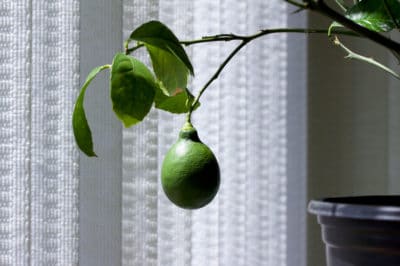Getting Started
To flower and fruit, your Meyer lemon needs eight or more hours of daily sunlight and an average temperature of around 65°F (18.3°C). A south- or southwest-facing window provides the sun. Keep the tree away from hot or cold drafts.
Potting
Give your Meyer lemon citrus potting mix or make your own mix with equal parts of:
- Organic potting soil
- Organic peat moss
- Perlite
Start the tree in a 5-gallon, 12- to 15-inch deep plastic pot with drainage holes. Fill the pot’s bottom third with moistened mix.
Slide the tree from its nursery container and untangle the roots. Center it in the pot and fill in around it, tamping gently to eliminate air pockets.
Stop about 1 inch below the rim to allow for watering. Adjust the tree if necessary so the trunk’s graft scar is between 4 and 8 inches above the soil. Water well, let it drain and water again.
Expert gardener’s tip: Expect to repot in a container one size larger every three to five years, until you’re using one one 2 feet wide and deep.
Continuing Care
A subtropical Meyer lemon needs 45 to 50 percent humidity. Mist its leaves regularly to keep at its best. Maximize its chances of bearing fruit by moving it outdoors when temperatures are consistently above 55 °F (12.8°C).
Put it in filtered shade and gradually increase its sun exposure. Reverse the process when moving it back indoors before your first fall frost date.
Watering
When the surface of the soil feels and looks very dry, water until the container is heavy and water flows from its drainage holes.
Expert gardener’s tip: A Meyer lemon with curling leaves could need watering. Test the soil first so you don’t overwater it. Soggy soil encourages root and crown rots.
Fertilizing
Give your Meyer lemon an organic, slow-release 6-3-3 fertilizer containing the trace minerals calcium, iron, zinc and manganese. Apply it at the label’s recommended amount and frequency.
Pest Management
Common pests on indoor Meyer lemons include:
- Scale insects
- Aphids
- Whiteflies
- Mealybugs
All these pests excrete sticky, ant-luring waste called honeydew. To manage them, spray the leaves and branches until they drip with organic insecticidal soap. Repeat twice weekly until the infestation ends.
